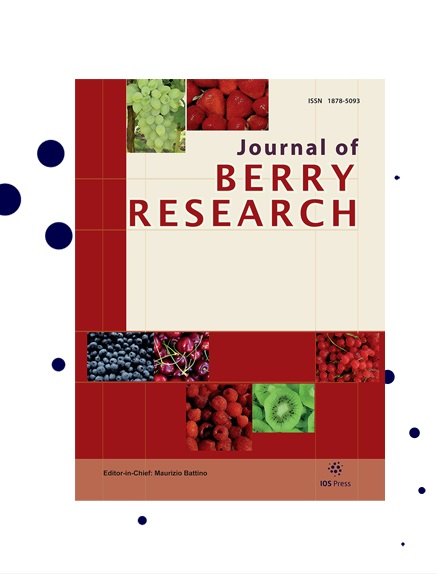Cloning, characterization, and ectopic expression in Arabidopsis to determine the function of FvSPL1 gene from woodland strawberry (Fragaria vesca)
IF 1.4
4区 农林科学
Q3 PLANT SCIENCES
引用次数: 0
Abstract
BACKGROUND: SQUAMOSA promoter binding protein-like (SPL) proteins are a class of plant-specific transcription factors that play important roles in plant development. However, the majority of SPL genes in strawberry are functionally uncharacterized. OBJECTIVE: To understand the biological functions and elucidate the molecular regulatory mechanisms of SPL genes in strawberry development. METHODS: The FvSPL1 gene from woodland strawberry was cloned and the phylogenetic tree was analyzed using bioinformatics methods. Subcellular localization, transcriptional activity, DNA binding ability and regulatory mechanisms of FvSPL1 were analyzed through biochemical and genetic approaches. RESULTS: Phylogenetic analysis with SPL genes from Arabidopsis, tomato and chrysanthemum indicated that FvSPL1 clustered in the same group as those of the miR156 target site located at the 3′-untranslated region. Further biochemical analysis indicated that FvSPL1 was exclusively localized in the nucleus. Electrophoretic mobility shift assay demonstrated that FvSPL1 could specifically recognize the GTAC motif. Transcriptional activity analysis showed that FvSPL1 is a transcriptional activator that could activate the expression of the FvAP1 gene. Finally, transgenic Arabidopsis overexpressing the FvSPL1 gene exhibited significantly early flowering. Taken together, our study indicated that FvSPL1, similar to its orthologs in Arabidopsis, mainly functions in regulating plant flowering. CONCLUSIONS: These findings provide insight into the mechanism of flowering in strawberry, and contribute to the understanding of strawberry flowering time manipulation which will facilitate the molecular breeding of strawberries.林地草莓FvSPL1基因的克隆、鉴定及异位表达
背景:SQUAMOSA启动子结合蛋白样蛋白(SPL)是一类在植物发育中发挥重要作用的植物特异性转录因子。然而,草莓中的大多数SPL基因在功能上是不典型的。目的:了解SPL基因在草莓生长发育中的生物学功能,阐明其分子调控机制。方法:克隆林地草莓FvSPL1基因,利用生物信息学方法对其系统发育树进行分析。通过生物化学和遗传学方法分析了FvSPL1的亚细胞定位、转录活性、DNA结合能力和调控机制。结果:对拟南芥、番茄和菊花SPL基因的系统发育分析表明,FvSPL1与位于3′-非翻译区的miR156靶位点聚在同一组中。进一步的生化分析表明FvSPL1仅定位于细胞核中。电泳迁移率转移分析表明FvSPL1可以特异性识别GTAC基序。转录活性分析表明FvSPL1是一种可以激活FvAP1基因表达的转录激活剂。最后,过表达FvSPL1基因的转基因拟南芥表现出显著的早期开花。总之,我们的研究表明,FvSPL1与其在拟南芥中的直向同源物相似,主要起到调节植物开花的作用。结论:这些发现深入了解了草莓开花的机制,有助于理解草莓开花时间的调控,这将有助于草莓的分子育种。
本文章由计算机程序翻译,如有差异,请以英文原文为准。
求助全文
约1分钟内获得全文
求助全文
来源期刊

Journal of Berry Research
Biochemistry, Genetics and Molecular Biology-Biochemistry
CiteScore
3.50
自引率
11.80%
发文量
21
期刊介绍:
The main objective of the Journal of Berry Research is to improve the knowledge about quality and production of berries to benefit health of the consumers and maintain profitable production using sustainable systems. The objective will be achieved by focusing on four main areas of research and development:
From genetics to variety evaluation
Nursery production systems and plant quality control
Plant physiology, biochemistry and molecular biology, as well as cultural management
Health for the consumer: components and factors affecting berries'' nutritional value
Specifically, the journal will cover berries (strawberry, raspberry, blackberry, blueberry, cranberry currants, etc.), as well as grapes and small soft fruit in general (e.g., kiwi fruit). It will publish research results covering all areas of plant breeding, including plant genetics, genomics, functional genomics, proteomics and metabolomics, plant physiology, plant pathology and plant development, as well as results dealing with the chemistry and biochemistry of bioactive compounds contained in such fruits and their possible role in human health. Contributions detailing possible pharmacological, medical or therapeutic use or dietary significance will be welcomed in addition to studies regarding biosafety issues of genetically modified plants.
 求助内容:
求助内容: 应助结果提醒方式:
应助结果提醒方式:


